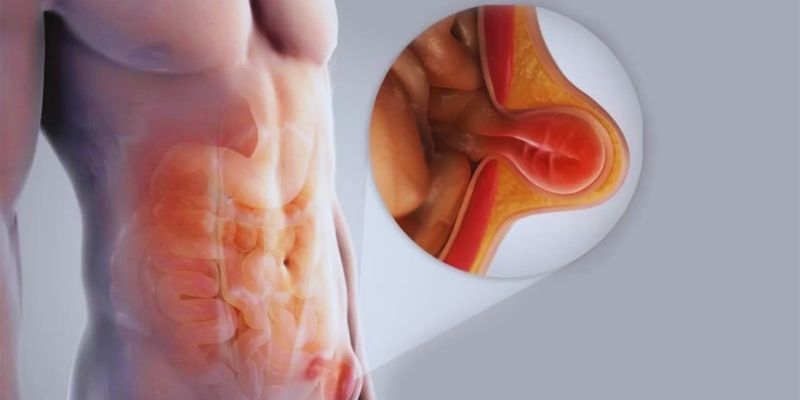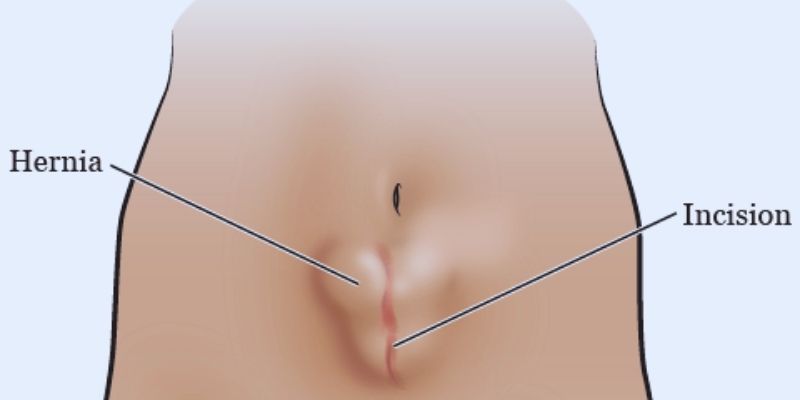Incisional hernias result from tissue pushing through an abdominal wall weak point. These hernias often develop at the site of a past surgical incision. Patients might find swelling, discomfort, or a clear bulge beside the scar. Among the risk factors are obesity, illness, or repeated abdominal operations. Untreated hernias can get bigger. Recovery could include both lifestyle changes and medical care.
Understanding the condition helps individuals seek timely care. One can advise appropriate diagnosis and treatment by a healthcare provider. Good post-operative care helps to heal and lowers risks. People should stay alert to any changes in their bodies. Early recognition of the problem ensures better results. Knowing the reasons behind incisional hernias and choices for therapy helps one make better health decisions.

Causes of Incisional Hernias:
Incisional hernias are caused mainly by improperly healed surgical incisions. Weak tissue at the incision site lets internal organs go past. Furthermore, raising the risk is inadequate surgical methods. Obesity strains the abdomen wall very heavily. That pressure could reopen previously healed sites. Heavy lifting stresses the area and results in ripping from chronic coughing. Infections at the surgical site compromise the tissue and slow down healing. Patients sometimes return to physical exercise far too soon following surgery. That strains the incision site.
Smoking alters tissue repair and could cause problems. Because of their slower recovery, people with diabetes also run more risk. Undergoing multiple procedures in the same area increases the risk of developing hernias. Proper wound care reduces the risk of incisional hernias. Maintaining a good weight helps one heal. Avoiding demanding activities also lowers dangers. Understanding the reasons enables patients to act with care. Starting post-operative care and knowledge of risk factors helps to prevent incisional hernias.
Common Symptoms to Watch For:
A bulge near a surgical scar is the most noticeable sign of an incisional hernia. When coughing or standing, the bulge could show more clearly. One further complaint is pain or discomfort close to the incision. When touched, the area could seem sensitive. One may experience abdomen swelling or a heavy sensation. Others have digestive problems like bloating or constipation. The skin around the bulge could seem red or inflamed. Nausea and vomiting might point to major issues. While lying down, the bulge may lessen but then show up upon moving. Over time, herns might grow and cause more pain.
The hernia could also cause difficulty doing regular duties. Some cases start free from symptoms. Still, after some time, discomfort normally starts to appear. Strangulated hernias are emergencies requiring immediate attention. They limit the blood supply to organs. Knowledge of these symptoms ensures early diagnosis. Early reporting of symptoms results in appropriate therapy. Awareness reduces major issues connected to incisional hernias.
Diagnosis and Medical Evaluation:
Doctors start diagnosis with an area of affected physical examination. They look for ripples around surgery scars. Hernias may become more visible when standing, coughing, or straining. Ultrasound and imaging tests provide a detailed view of internal tissues. CT scans provide a detailed view of the abdominal wall. These tools support the confirmation of the position and dimensions. Doctors also evaluate any potential complications during the assessment. Doctors may use blood tests to check for infections. A complete medical history supports the correct diagnosis.
One often-asked question concerns past procedures. Knowing symptoms helps one to estimate the degree of the ailment. Sometimes, hernias are hard to find. Advanced imaging scans are essential for detecting deep tissue or hidden incisional hernias. These tests help doctors confirm the hernia’s size, location, and severity. One could keep an eye on non-surgical patients. However, untreated hernias can gradually worsen over time. Early diagnosis makes treatment planning more effective. A specialist can explain the available options and recommend the best approach. Regular follow-ups are important for patients being observed without surgery. Delaying care increases the risk of serious complications. That’s why early medical evaluation is so important.
Treatment Options for Incisional Hernias:
Surgical repair is the most effective treatment for incisional hernias. Patients usually choose between open surgery and laparoscopic methods. Fewer cuts and faster recovery are features of laparoscopic surgery. Surgeons use mesh to assist the weakened area. Mesh lessens the possibility of a hernia returning. The degree of the hernia and the patient's condition determines the recovery duration. Rest and painkillers help heal. During rehabilitation, avoid excessive lifting. Some minor hernias might not call for right away surgery. In such situations, one can choose to wait attentively. To stop more damage, doctors usually advise lifestyle modifications.
Reducing weight helps the abdominal wall to be less under strain. Quitting smoking speeds up healing. In some situations, wearing a support belt could help. One can use antibiotics to ward against illnesses. Following surgery, physical therapy can help muscles get stronger. Correct diagnosis ensures an appropriate course of action. Working with a specialist guides the choices of treatment. Proper treatment ensures recovery and helps to avoid incisional hernia complications.

Risks and Complications:
Untreated incisional hernias can cause major problems. Strangulation is the most dangerous issue. It results from a hernia trapping some of the intestines. It results in tissue death and shuts down blood flow. Such circumstances call for emergency surgery. Another risk is incarceration, where hernia contents become trapped and cannot return. Pain and digestive problems may result from incarceration. Infections can also develop around the hernia, especially after surgery. There's a risk of the hernia returning, even after treatment. Sometimes, the surgical mesh used for repair may shift or irritate.
Scar tissue can develop all around the surgery site. It could cause long-term discomfort. Bowel obstruction is another serious risk associated with incisional hernias. It makes one very uncomfortable and induces vomiting. Delayed therapy raises these risks. Early medical treatment helps to avoid harmful results. Closely observing symptoms is essential. You really should talk to your doctor about warning signals. Knowing these consequences helps one choose the appropriate treatment. Properly managing health following surgery helps prevent hernia-related problems down the road.
Conclusion:
Common following abdominal surgery are incisional hernias. They result from weak muscles at the incision site—early identification of symptoms and getting treatment help to avoid later issues. Usually, treatment calls for careful recovery and surgical correction. Lifestyle changes may decrease the chance of recurrence. Healing requires medical advice in great part. Maintaining knowledge and initiative helps to ensure a smooth recovery. Most patients heal completely and prevent major problems with the correct treatment. Long-term health and well-being following surgery depend on an awareness of the causes of incisional hernias and exploring incisional hernia treatment alternatives.












